It's the ecology, stupid! (original) (raw)
Stem cells are engaged in constant crosstalk with their environment, biologists are fast realizing. So the emerging field of regenerative medicine is now wrestling with the ecological concept of the niche. Kendall Powell reports.
Linheng Li is learning to think like an ecologist. His study subjects put down roots near sources of nourishment and depend on other living things in their environment to thrive. But Li doesn't have mud on his boots. The ‘species’ he studies are stem cells and the ‘ecosystem’ is bone marrow.
Within the anatomical forest of the marrow, Li's stem cells occupy specific niches — a term borrowed from ecology. An organism's ecological niche is a definition of where it lives, what it does, and how it interacts with its environment. Alter that environment, and the consequences for the organism can be dire. Conversely, if you take an organism and deposit it in an alien ecosystem, all hell can break loose.
At the Stowers Institute for Medical Research in Kansas City, Missouri, Li thinks in a similar way about stem cells. For example, in aplastic anaemia, stem cells are unable to produce sufficient blood cells, even though they look normal. Something about the cells' microenvironment in the bone marrow may be awry, argues Li. “It's like the soil being damaged,” he says. Similarly, just as an introduced species can run amok in its new environment, stem cells placed in the wrong tissue in the body might conceivably form a malignant tumour.
Clearly, you can't hope to understand a woodland flower's niche in the forest by examining a specimen grown in a pot. And biologists are realizing that they are missing an important part of the picture by studying stem cells in Petri dishes. “Thinking of stem cells in isolation can be productive,” says David Scadden, co-director of the Harvard Stem Cell Institute in Boston. “But it falsely simplifies what is a single component of a much larger, more complex system.”
Indeed, this jungle of stem cells, support cells, protein scaffolds, blood vessels and biochemicals may be every bit as complex as a forest ecosystem. And teasing apart the ‘ecological’ interactions involved may be crucial if stem cells are to fulfil their therapeutic promise, and eventually be deployed to grow specialized cells and tissues to replace those lost to injury or disease.
So far, scientists have begun to define stem-cell niches for just a handful of tissues. Li's and Scadden's groups, for example, have partially defined the niche of blood-forming haematopoietic stem cells in bone marrow. Biologists suspect that the signalling pathways that help to define different stem-cell niches share common characteristics. But the details are likely to vary from tissue to tissue.
No place like bone
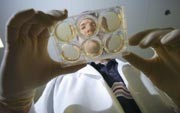
Missing a trick: studying stem cells in culture overlooks interactions with their environment. Credit: S. HUFFAKER/GETTY IMAGES
Researchers working with haematopoietic stem cells first proposed that the cells responded to their microenvironment almost four decades ago1. “They realized there was something special in the bone marrow — that it was an idyllic hideaway where stem cells could live for ever. As they leave the region, they are doomed to differentiate,” says Haifan Lin, a stem-cell researcher at Duke University Medical Center in Durham, North Carolina.
But at that time, biologists lacked the molecular tools to reveal why bone marrow is a safe haven for its stem cells. They needed cell-surface markers that would distinguish stem cells from the other cell types present. And without gene knockout technologies, they were unable to eliminate components of the bone marrow environment to find out which ones were crucial for stem-cell survival.
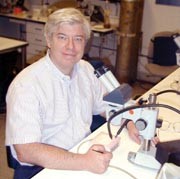
Allan Spradling was one of the first to draw parallels between stem-cell biology and ecological niches. Credit: K. BELSCHNER
When such tools appeared in the 1990s, they were first applied to a simpler system, in which it is easier to track the fates of individual cells. The gonads of fruitflies contain germline stem cells that give rise to sperm or eggs. These stem cells are held in sharply defined microenvironments, surrounded by just a few cellular neighbours.
Around the turn of the millennium, two research groups showed that a tight pocket of support cells physically holds on to the stem cells, lining them up to divide properly. The oriented divisions ensure that one daughter cell remains in this pocket, where it receives specific biochemical signals that maintain its ‘stemness’2,3. The other is pushed out to start moving down the developmental pathway that gives rise to sperm or eggs.
“The stem cells may just be following along, not really calling the shots,” suggests Allan Spradling, director of the Carnegie Institution's Department of Embryology in Baltimore, Maryland. If the germline stem cells are removed, other cells — including those that have begun to differentiate — move in to take their place4. Similar dynamics can operate in ecosystems, if one species is wiped out.
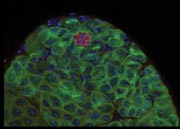
Germline stem cells in fruitfly testis surround a ‘hub’ of cells (red) that direct stem-cell renewal. Credit: L. JONES
In their pioneering papers2,3, Spradling's team and the second group, led by Margaret Fuller of Stanford University in California, equated the term ‘niche’ with the microenvironment in which stem cells sit. Others have followed this convention. But from a strict ecological perspective, this is a misnomer — it's more of a nook, than a niche. In ecology, a niche describes a living thing's specific interaction with its environment, more like a job description than an address.
Regardless of the way in which the terminology is used, it's becoming clear that ‘ecological’ interactions are central to stem-cell biology. “The fly research has laid the groundwork,” says Leanne Jones, formerly a postdoc with Fuller, now running her own lab at the Salk Institute for Biological Studies in La Jolla, California. The next challenge is to tease apart the ways in which the various types of stem cells found in adult mammalian tissues interact with their microenvironments.
The best-studied mammalian adult stem cells are in skin, intestine, bone marrow and a few specialized regions of the brain where new neurons form. In each case, specific support cells seem to hold stem cells in place, and help to direct the production of daughter cells that differentiate to form specialized cells and tissues.
In the bone marrow, for instance, Li and Scadden have shown that cells called osteoblasts lining the inner bone surface are closely associated with haematopoietic stem cells, encouraging their division and regulating their subsequent differentiation into the precursors of blood cells5,6. In a brain region called the hippocampus, neural stem cells take their cues both from cells called astrocytes and from the endothelial cells that line blood vessels7,8. Generally speaking, it seems that endothelial cells encourage stem cells to stay put and renew themselves8, whereas astrocytes say ‘become a neuron’7.
Researchers are now trying to tease apart the biochemical signalling going on between adult stem cells and their support cells. It seems that these often involve the same molecular pathways that direct tissue generation during embryonic development — such as the Wnt, Notch and TGF-β/BMP pathways familiar to cellular developmental biologists. “Maybe a stem cell is like the embryonic stage and is still able to respond to at least one of these pathways,” says Li.
In some cases, stem cells are physically anchored to their support cells; here, biochemical signalling may require physical contact between cell-surface receptors. For instance, osteoblasts bear a membrane protein called jagged 1, which fits into and activates a receptor called Notch carried on the surface of haematopoietic stem cells. This stimulates the Notch pathway, which encourages the stem cells to keep dividing to renew themselves6.
Location, location, location
In other tissues, such as the skin, support cells have a looser association with their stem cells. And in many cases, cellular communication is by diffusible biochemicals. The blood supply is also an important part of the microenvironment — many stem cells have blood vessels nearby, which may alert them to the physiological state of the whole organism. Some stem cells, such as those in bone marrow, can even migrate into blood vessels, circulate around the body, and return home when needed.
Thinking like an ecologist can help when trying to understand such complex behaviour. Neural stem cells, for instance, stay put in the hippocampus, but their relationship with blood vessels may be every bit as important as the relationship of plants with streams and rivers. “Sitting right up next to a blood vessel versus just being nearby may make a huge difference to a stem cell,” says Fred Gage, whose lab at the Salk Institute has led the way in characterizing neural stem-cell niches.
Gage's group has also found that mammalian neural stem cells are not such passive players in their microenvironment as the fruitfly germline stem cells studied by Spradling and Fuller. Andrew Wurmser, a postdoc in Gage's lab, has found that neural stem cells can, under certain conditions, give rise to endothelial cells9. This hints that, if the need arises, they may be able to populate their microenvironment with the support cells that they need to thrive.
Researchers led by Elaine Fuchs of Rockefeller University in New York have added further weight to the idea that some stem cells can create their own microenvironments. She has isolated individual epithelial stem cells, which give rise to skin and hair, and cultured them in the lab. When she subsequently grafted cells from these cultures into the skin of mutant hairless mice, they gave rise to hair follicles containing stem cells and support cells10. The nude mice grew tufts of hair.
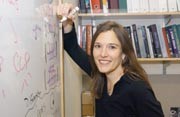
Leanne Jones says turning stem cells into specific tissues will mean replicating their niche in the lab. Credit: SALK INST.
Many researchers want to work out whether adult stem cells can be induced to widen their horizons from their usual niche, and give rise to different cells and tissues. The idea that some stem cells can ‘transdifferentiate’ in this way has been hugely controversial, with many early findings now dismissed as artefacts. “If you put a haematopoietic stem cell into a neural stem-cell niche, does it become a neural stem cell, or will it respond differently? We still don't know,” says Wurmser.
Transdifferentiation remains an important question. For some diseases that might, in theory, be treated using stem cells, no appropriate natural stem cell has yet been identified — type 1 diabetes, where the pancreas loses its insulin-secreting β-cells, is the best-known example. Many researchers wonder whether an improved understanding of stem-cell microenvironments will provide clues about how to send stem cells down different developmental pathways, or reactivate quiescent stem cells. Perhaps a haematopoietic stem cell will give rise to a β-cell if placed in a pancreas-like environment. Maybe one day it will even be possible to devise niche-altering drugs.
Niche market
Some clinicians want to use adult stem cells to repair patients' failing bodies. Even if they don't need to invoke transdifferentiation, they may benefit from adopting an ecological mind-set. For some treatments, it may first be necessary to greatly expand stem-cell numbers by culturing them in the lab. Will the cells need to be grown in a realistic microenvironment to maintain their ‘stemness’, or will a simple bath of chemicals do? Some researchers argue that providing an appropriate three-dimensional environment in which signals come from the right direction will matter as much as using the right biochemicals. The same may go for getting stem cells to give rise to the appropriate tissues. “You do need an organized environment,” argues Jones.
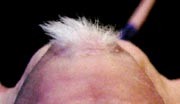
Stem cells implanted in this nude mouse created their own microenvironment and grew hair. Credit: REF. 10/ELSEVIER
Of course, many stem-cell biologists are working with embryonic stem cells, rather than adult stem cells. Found in blastocysts — embryos consisting of a hollow ball of cells — embryonic stem cells have the potential to give rise to all of the body's tissues. They don't live in such complex microenvironments as their adult counterparts, but the new wave of ecological thinking may still help to bring embryonic stem cells into the clinic.
“Just injecting embryonic stem cells is probably not the way to go,” says Fuchs. “Left to their own devices, they do their own thing and go in different directions.” Instead, most researchers working with embryonic stem cells are trying to get them to differentiate into specific cell types in the lab. But to unlock the cells' potential fully, biologists may need to find ways to recapitulate the changing microenvironments that characterize the long journey from embryonic stem cell to adult tissue.
With an ecosystem as complex as the human body, attempting to recreate the precarious balances found in nature is no small task. To find the optimal conditions for stimulating stem cells therapeutically, biologists will need to know how stem cells and their neighbours depend on one another for survival. And they must test how far a system's equilibrium can be pushed before stem cells are wiped out or turn cancerous. The parallels with the local species extinctions and population explosions that can occur if a natural ecosystem is disturbed are clear.
Many stem-cell biologists have already made their travel plans for next month's meeting of the International Society for Stem Cell Research in San Francisco. Perhaps some should put another date in their diary: the Ecological Society of America meets in Montreal, Canada, from 7 to 12 August.